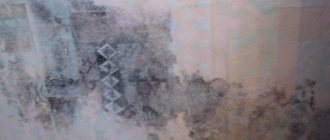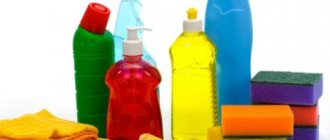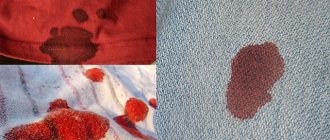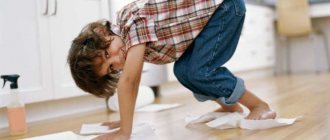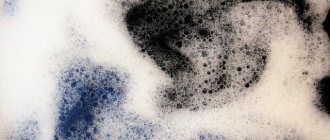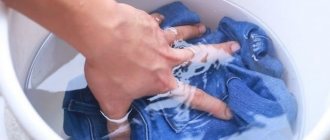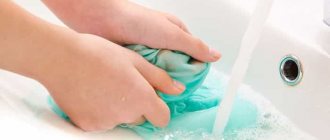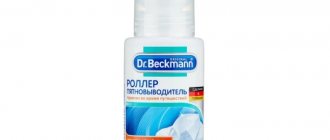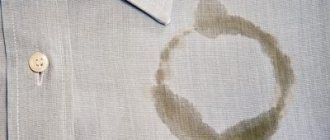Share on social media networks:
Renovation, despite the labor intensity, is not a rare occurrence in an apartment, because you want to periodically update your home, breathe into it, if not new life, then at least new wallpaper. But often the installation of such a decorative coating ends with the appearance of unsightly stains from diluted glue on the surface of freshly glued walls. And no one is immune from this kind of oversight. Such stains are especially visible on dark plain canvases, and they spoil the entire impression, and at the same time the mood of the apartment’s inhabitants. And the question arises, how to remove glue from wallpaper after gluing. Let's first look at the reason for the appearance of these spots.
Why do glue stains appear?
There are several reasons for this kind of trouble:
- The wall must be clean, puttied and coated with a special antifungal primer. Glue stains may appear if the wall was not properly prepared for use. Before laying a new decorative covering, it is necessary to clean the wall of all remnants of old wallpaper. If the wall is made of plasterboard, it needs to be puttied. Putty is also necessary if there are lime stains on the wall. Otherwise, they will interact with the glue. This will lead to the formation of yellow spots, which cannot be removed later.
- You cannot glue the canvas to a wet wall.
- Walls from old wallpaper must be thoroughly washed.
- It is not recommended to apply the glue in a layer that is too thick; if the excess is not removed in time, stains are guaranteed to remain.
- When gluing non-woven coverings, the glue is applied only to the wall, this is enough for the panels to stick well. Excess glue should be removed with a wet cloth.
- Sometimes the wallpaper doesn't stick well and you start adding too much glue. But the reason may be that the glue was not diluted correctly. Dilute the glue strictly according to the instructions, do not allow lumps to form.
Removing paper wallpaper from plasterboard walls
The difficulty lies in the fact that the drywall is covered at the top with a paper layer, which must be left intact.
In such a situation, the most optimal way is to use not water, but special products that dissolve exclusively wallpaper glue.
For those who doubt their abilities, we suggest watching a video about the quick and easy removal of old paper wallpaper from walls:
Additional information: How to remove old wallpaper from a wall with paint
Before performing work, be sure to read the safety precautions. Remember that there are outlets and wiring on the walls. For safety, completely turn off the electricity by unscrewing the cap on the meter.
Next, cover all sockets with masking tape or electrical tape so that the liquid does not short-circuit the contacts.
Poor wall preparation is one of the most common reasons for wallpaper coming off. The surface is considered prepared for work when:
- there are no traces of old wallpaper or traces of previous whitewash on the wall;
- There are no depressions or bumps, all cracks are carefully repaired;
- the working surface is well primed.
If you pre-sprinkle them with water before the removal procedure, as many do with paper wallpaper, the penetration of moisture into the internal structure of the canvas will be prevented by the polyvinyl chloride layer. What to do in this case? You need to do the following:
Attention: Do not rub the plaster or concrete wall too intensely, especially in old houses and apartments. The material crumbles and falls off, leaving holes and dents
You have to spend extra time and money on priming and leveling the walls for new wallpaper.
- It’s great if you still have labels from the rolls that indicate the type of dismantling, for example, “remove wet” or “delaminate when removed.”
- Before you start removing old wallpaper, remember how it was applied. If it was ordinary wallpaper glue that was applied to primed walls, then most likely the entire dismantling process will not be very difficult.
- Problems may arise if the wallpaper was glued with non-standard glue, such as PVA, or was mounted on an unsuitable surface. The most difficult surface is considered to be unputtyed drywall.
- Some difficulties may arise if the top layer does not absorb moisture (vinyl and washable wallpaper), but effective methods have been invented for this case.
It can take two hours to clean the walls of a 20 square meter room. More time may be needed in cases where old paper wallpaper is glued properly, or even worse, with PVA glue. It will also take longer to process materials with a water-repellent layer, such as vinyl wallpaper.
In residential buildings, it will be much easier to hang wallpaper in the fall or winter, because they are equipped with a heating system and constantly maintain a certain temperature. Difficulties may arise here with air humidity, but even here you can always find a solution to the problem.
First you need to find out why it is advisable to remove the old wallpaper before hanging new ones. And in this case, the answer is obvious: if there are dirty spots on the surface of the wall, then they can easily show through the new finishing layer, moreover, the adhesive solution will soften the old canvases and, as a result, the new trellises may not be properly glued. That is why it is better to tear off old wallpaper, but we will talk further about how this can be done without extra effort.
– Select a tool. To remove wallpaper, you will need sharp spatulas (sizes may vary), a paint roller and a sharp knife. For easier cleaning, floors can be covered with unnecessary newspapers or film; for better fixation, use masking tape.
A chair and stepladder will be needed to remove wallpaper from the tops of the walls. In some cases, a special liquid is used to make wallpaper removal easier, and even, possibly, a household steam generator. In particularly difficult situations, a grinding machine is used.
Having decided on the missing tool, it is worth purchasing the missing items at a building materials store.
- The selected area is treated with a “wallpaper tiger”, a wire brush or a needle roller.
- The wallpaper is moistened with warm water or steam from top to bottom.
- The moistened fragments are pryed from the edge (at the junction of the panels) with a spatula or scraper and, if possible, carefully and evenly pulled away from the wall.
- Areas of the surface where pieces of wallpaper and/or older coating remain are additionally cleaned. How to easily remove old paint from concrete walls? You can use sandpaper with a grit of 36...60 grid.
Preventing the appearance of glue stains
In order not to rack your brains about how to remove glue from wallpaper after gluing, you need to follow the following recommendations:
- When applying glue, it is best to use a wide natural bristle brush. Then the glue will be distributed evenly and there will not be too much of it.
- Lubricate the strips of decorative covering with glue generously, but not so much that after applying the panel to the wall, it shows through the seams. And if this does happen, remove the excess with a clean, damp cloth.
- After laying the strips of decorative coating, the seams need to be blotted with a clean rag or sponge, then go over the wallpaper with a special roller. If after this excess glue comes out, they also need to be wiped with a rag.
- There should be no drafts or too low temperatures in the room where the wallpaper is glued.
How to remove glue from wallpaper
It seemed like the renovation would take forever! But now, the last thorough repair work has been carried out, the floors have been finished, wallpaper has been hung, and - bad luck: in some places traces of dried glue are clearly visible. What to do? Is it really necessary to start all over again? Fortunately, no! In this article we will talk in detail about how to independently remove adhesive stains from the surface of wallpaper without damaging it at all.
Removing glue stains from wallpaper: how to do it correctly
As practice shows, it is almost impossible to remove dried glue from wallpaper without damage. However, if you have non-woven wallpaper, which is characterized by extreme resistance to external negative factors (including all kinds of mechanical damage), you can try to do this without the risk of damaging their appearance. To begin, arm yourself with a regular foam sponge soaked in water - perhaps the adhesive composition will succumb to such a minor impact. Use it to treat a separate cut piece of wallpaper - if it doesn’t get wet, then feel free to proceed with further manipulations with the contaminated area.
Additionally, let's take into account the fact that some types of wallpaper are pre-designed for washing according to the manufacturer's plans (this is indicated on their packaging using a marker in the form of three wavy lines). Therefore, you can, without a twinge of conscience, try to remove the stain with a soap solution.
If we are not talking about expensive professional adhesive mixtures, but about homemade glue, cleaning the wallpaper from its residue will not be difficult. In particular, glue based on modified starch can be dealt with quite easily using improvised means.
Removing fresh glue from wallpaper
Very often, when gluing heavy wallpaper, for which you have to dilute thicker glue, situations arise when excess glue cannot be simply removed with a rag. In this case, you can do the following:
- Take a clean sponge, soak it in warm water and squeeze thoroughly.
- Rub the stain in a circular motion, rinsing and squeezing the sponge until all traces of the fixative are removed.
Important! Vinyl or non-woven wallpapers are resistant to such influences, but paper ones require especially careful handling. Sometimes it makes sense to leave it as is rather than wipe the surface with a sponge to holes.
Removing glue from the front surface of wallpaper
For work you may need:
Tools for removing glue: rags, spray bottle, stain remover, marker, wallpaper remnants, decorative elements.
- damp rags;
- spray;
- special composition for removing stains;
- felt-tip pen or marker;
- wallpaper remnants;
- decorative elements (paintings, clocks, panels, etc.).
It happens that the glue gets on the decorative part of the panel, it shines and has a different color. This deficiency can be eliminated. But removing dried glue is more difficult than fresh glue. In the case when you have hung thick wallpaper, for example, vinyl, which can be washed, and the glue has dried, you need to moisten the sponge, lightly treat the canvas, and leave for a few minutes. The main thing is not to rub too intensely, not to spoil the design, not to rub into the hole. The thinner the wallpaper structure, the more care and caution is required. You can also carefully remove glue in this way from light non-woven wallpaper.
There are brands of wallpaper glue that, after some time of drying, become thin transparent films that can be removed without difficulty or leaving any traces. When the wallpaper paste is fresh, it is best to remove it with a damp sponge or rag, first removing the excess. When purchasing an adhesive composition, it is advisable to purchase a special product (ideally from the same manufacturer as the glue), which is designed to remove stains of various origins from the surface of the wallpaper, including those left by the glue.
When the glue remains on the dark non-woven panels, it is visible on the seams, the situation is hopeless, it will not be possible to remove the dried adhesive, the bleed-through compound is removed during the lining process. But light-colored seams can be disguised, painted over with a marker to match the color of the panels, after first checking this method on an area that is not visible to the eye. In the event that a stain remains or the appearance of the wallpaper is damaged, you can make a restoration using exactly the same roll or use decorative decorations.
By following simple rules for removing glue from the decorative part of wallpaper, gluing technology, being careful and diligent, and choosing the right adhesive, you can avoid problems associated with traces of glue.
How to carefully remove glue from wallpaper
Repair is a pleasant and at the same time troublesome process. Pleasant, because your rooms take on a new and beautiful look, but troublesome, because after that you have to remove all the dirt, one of which is wallpaper glue. But you can solve this problem if you stock up on a spray bottle, soft cloth, decorative elements, glue, water and a special stain remover.
Necessary products for cleaning wallpaper
Removing dried glue
Removing dried glue from wallpaper is much more difficult. Before this, it is worth analyzing the situation; if the glue is not very noticeable, and the wallpaper has a delicate structure, then it is wiser to leave everything as is.
In what situations is it recommended to remove dried glue?
- If stains on dark wallpaper catch your eye.
- If the marks are in places where the light falls and the difference in shades of the canvas is visible.
- If you have an elite renovation, such flaws simply shouldn’t happen.
If you have heavy, dense wallpaper, then it can be subjected to a wet or dry cleaning procedure.
Wet cleaning
How to remove dried glue from wallpaper? To do this you will need a spray bottle:
- Spray water from it evenly onto problem areas.
- Wait 10-15 minutes
- Gently wipe these areas with a soft sponge or cloth.
- If the marks are not wiped off immediately, you can repeat the procedure, provided that the wallpaper can withstand it.
How to remove glue from non-woven wallpaper? Such wallpaper can even be cleaned with a brush. Just try it on an inconspicuous place first. Rub them with a damp sponge using a gentle detergent. If the wallpaper is not damaged, then you can continue the stain removal procedure.
Such different compositions:
- If the glue is starch based, you can use vinegar when cleaning. It will react with starch and destroy its structure.
- PVA glue can be removed using warm water with vinegar or vodka diluted in it.
If the glue is based on modified starch, then you can do the following:
- Cover the area with dried glue with a paper towel.
- Spray window or mirror cleaner on top.
- Leave for 15 minutes.
- Remove the napkin and then blot the treated area with a dry paper towel.
- Let this area dry on its own.
Important! The wet area should not be dried with a hairdryer.
Dry cleaning
Here we will need a dishwashing sponge, on the other side of which there is a seal and a brush with soft bristles:
- Rub the glue firmly with the side of the sponge. If the sponge cannot cope, then a brush will come to its aid.
- After removing the glue, wipe the area thoroughly with a soft cloth.
- If after treatment the stain has not completely disappeared and the wallpaper has not been damaged, the procedure can be repeated.
Features by type of canvas base
On the modern market of finishing materials there is a wide range of wallpaper coverings. Wallpaper is made from a wide variety of materials. Some of the subtleties of the process of removing wallpaper from walls and ceilings will depend on the specific type of wallpaper covering.
Non-woven
Non-woven wallpaper is made from cellulose fiber and special additives. Non-woven fabric has a durable fabric-like structure. This material is resistant to moisture and tearing. The top layer of coating can be easily removed. It is enough to grab the edge of the wallpaper and then tear the canvas away from the bottom layer. You can glue new wallpaper onto the remaining base.
Peeling off waterproof non-woven wallpaper completely is quite difficult. First, the top layer is removed, after which it is necessary to remove the base. The simplest method is to soak the surface with warm soapy water, then remove the bottom layer with a spatula. Washable non-woven models can be removed using a steam generator. High-temperature steam softens the glue, after which you can easily remove the covering from the wall in whole sheets.
Paper
Old paper wallpaper is not so easy to remove from a wall. This material tears very easily, so it will not be possible to remove the wallpaper in one piece. You can pre-make cuts on the paper covering. The surface must be moistened with water. It is also possible to prepare a special solution. To prepare a soaking solution, simply dilute vinegar or dishwashing gel in warm water. Within twenty minutes the wallpaper should begin to swell. After this, you can begin removing the paper pieces from the wall.
If the wallpaper was glued with a PVA mixture, you will have to resort to a more radical method of cleaning the surface. The coating must be removed using a drill with a metal brush attachment. The most effective means for removing paper wallpaper are specialized mixtures; steam treatment can also be used. Painted paper wallpaper can be cleaned using a steam generator. First you need to try to at least partially remove the top layer of paint.
Vinyl
Vinyl wallpaper is a two-layer material. The bottom layer is made of paper or non-woven fabric. The top vinyl layer is made from PVC. It has a high level of moisture resistance. To remove such a coating using the standard method of soaking the surface, you need to put in a lot of effort. To make it easier for moisture to access the bottom layer of wallpaper, it is necessary to break the integrity of the vinyl covering using a wallpaper “tiger”. Then you need to thoroughly moisten the wallpaper material with warm water and remove the coating using a metal spatula.
PVC wallpaper can be easily removed after steaming the surface. This method will require a steam generator or iron. The adhesive layer will soften under the influence of steam, which will allow you to remove the wallpaper from the wall without much effort. In more complex cases, when the vinyl coating is difficult to remove, you should use special store-bought wallpaper removers. This product must be mixed with wallpaper adhesive, applied to the walls, and left for three hours. The wallpaper can be easily removed in one piece.
Liquid
Liquid wallpaper is quite easy to remove from the surface. The coating must be removed gradually, breaking the entire surface into small sections. A small area is well moistened with water or a special product. The liquid should be well absorbed into the structure of the liquid wallpaper. To do this, just wait about ten minutes.
After the layer of liquid wallpaper has soaked, it can be easily cleaned off using a metal spatula or paint scraper. To remove this type of coating, you can also use a hair dryer.
Self-adhesive
Self-adhesive wallpaper is a PVC film with a layer of dry glue applied to the back side. Most types of self-adhesive coatings can be easily removed from the surface without the use of any special methods or means. If the film cannot be easily peeled off from the surface, you can moisten the coating with hot water. The adhesive under the wallpaper should soften after a few minutes, after which you can peel off the film with a spatula. The most effective tool for removing self-adhesive wallpaper is a hair dryer. Under the influence of hot air, the coating will soften and begin to lag behind the wall.
Special means
Is there any product to remove glue from wallpaper? If your wallpaper is thick enough, you can try the “Super Moment Anti-Glue” product. It is suitable for removing PVA, polyurethane based adhesives, etc.
Important! Be sure to test it on a small, inconspicuous area before applying it.
Mode of application:
- Apply to the problem area and leave for 60 minutes.
- Then wipe with a dry cloth and wash the area with soapy water.
Removing glue from the front surface of wallpaper
For work you may need:
Tools for removing glue: rags, spray bottle, stain remover, marker, wallpaper remnants, decorative elements.
- damp rags;
- spray;
- special composition for removing stains;
- felt-tip pen or marker;
- wallpaper remnants;
- decorative elements (paintings, clocks, panels, etc.).
It happens that the glue gets on the decorative part of the panel, it shines and has a different color. This deficiency can be eliminated. But removing dried glue is more difficult than fresh glue. In the case when you have hung thick wallpaper, for example, vinyl, which can be washed, and the glue has dried, you need to moisten the sponge, lightly treat the canvas, and leave for a few minutes. The main thing is not to rub too intensely, not to spoil the design, not to rub into the hole. The thinner the wallpaper structure, the more care and caution is required. You can also carefully remove glue in this way from light non-woven wallpaper.
There are brands of wallpaper glue that, after some time of drying, become thin transparent films that can be removed without difficulty or leaving any traces. When the wallpaper paste is fresh, it is best to remove it with a damp sponge or rag, first removing the excess. When purchasing an adhesive composition, it is advisable to purchase a special product (ideally from the same manufacturer as the glue), which is designed to remove stains of various origins from the surface of the wallpaper, including those left by the glue.
When the glue remains on the dark non-woven panels, it is visible on the seams, the situation is hopeless, it will not be possible to remove the dried adhesive, the bleed-through compound is removed during the lining process. But light-colored seams can be disguised, painted over with a marker to match the color of the panels, after first checking this method on an area that is not visible to the eye. In the event that a stain remains or the appearance of the wallpaper is damaged, you can make a restoration using exactly the same roll or use decorative decorations.
By following simple rules for removing glue from the decorative part of wallpaper, gluing technology, being careful and diligent, and choosing the right adhesive, you can avoid problems associated with traces of glue.
Removing glue from the front surface of wallpaper
For work you may need:
Tools for removing glue: rags, spray bottle, stain remover, marker, wallpaper remnants, decorative elements.
- damp rags;
- spray;
- special composition for removing stains;
- felt-tip pen or marker;
- wallpaper remnants;
- decorative elements (paintings, clocks, panels, etc.).
It happens that the glue gets on the decorative part of the panel, it shines and has a different color. This deficiency can be eliminated. But removing dried glue is more difficult than fresh glue. In the case when you have hung thick wallpaper, for example, vinyl, which can be washed, and the glue has dried, you need to moisten the sponge, lightly treat the canvas, and leave for a few minutes. The main thing is not to rub too intensely, not to spoil the design, not to rub into the hole. The thinner the wallpaper structure, the more care and caution is required. You can also carefully remove glue in this way from light non-woven wallpaper.
There are brands of wallpaper glue that, after some time of drying, become thin transparent films that can be removed without difficulty or leaving any traces. When the wallpaper paste is fresh, it is best to remove it with a damp sponge or rag, first removing the excess. When purchasing an adhesive composition, it is advisable to purchase a special product (ideally from the same manufacturer as the glue), which is designed to remove stains of various origins from the surface of the wallpaper, including those left by the glue.
When the glue remains on the dark non-woven panels, it is visible on the seams, the situation is hopeless, it will not be possible to remove the dried adhesive, the bleed-through compound is removed during the lining process. But light-colored seams can be disguised, painted over with a marker to match the color of the panels, after first checking this method on an area that is not visible to the eye. In the event that a stain remains or the appearance of the wallpaper is damaged, you can make a restoration using exactly the same roll or use decorative decorations.
By following simple rules for removing glue from the decorative part of wallpaper, gluing technology, being careful and diligent, and choosing the right adhesive, you can avoid problems associated with traces of glue.
Removing glue from the front surface of wallpaper
For work you may need:
Tools for removing glue: rags, spray bottle, stain remover, marker, wallpaper remnants, decorative elements.
- damp rags;
- spray;
- special composition for removing stains;
- felt-tip pen or marker;
- wallpaper remnants;
- decorative elements (paintings, clocks, panels, etc.).
It happens that the glue gets on the decorative part of the panel, it shines and has a different color. This deficiency can be eliminated. But removing dried glue is more difficult than fresh glue. In the case when you have hung thick wallpaper, for example, vinyl, which can be washed, and the glue has dried, you need to moisten the sponge, lightly treat the canvas, and leave for a few minutes. The main thing is not to rub too intensely, not to spoil the design, not to rub into the hole. The thinner the wallpaper structure, the more care and caution is required. You can also carefully remove glue in this way from light non-woven wallpaper.
There are brands of wallpaper glue that, after some time of drying, become thin transparent films that can be removed without difficulty or leaving any traces. When the wallpaper paste is fresh, it is best to remove it with a damp sponge or rag, first removing the excess. When purchasing an adhesive composition, it is advisable to purchase a special product (ideally from the same manufacturer as the glue), which is designed to remove stains of various origins from the surface of the wallpaper, including those left by the glue.
When the glue remains on the dark non-woven panels, it is visible on the seams, the situation is hopeless, it will not be possible to remove the dried adhesive, the bleed-through compound is removed during the lining process. But light-colored seams can be disguised, painted over with a marker to match the color of the panels, after first checking this method on an area that is not visible to the eye. In the event that a stain remains or the appearance of the wallpaper is damaged, you can make a restoration using exactly the same roll or use decorative decorations.
By following simple rules for removing glue from the decorative part of wallpaper, gluing technology, being careful and diligent, and choosing the right adhesive, you can avoid problems associated with traces of glue.
During cladding work, when covering walls with wallpaper, glue often gets onto the front part of the panel. The building materials industry produces many brands of wallpaper glue, which, when it gets on their front part, dries out without a trace and disappears. But there is also glue that can stain them and look like an unaesthetic stain, causing a lot of trouble. Many people are interested in the question of how to remove glue from wallpaper.
If the wallpaper paste has not yet dried, you should carefully rub the stain with a slightly moistened sponge.
In order for the wallpaper to maintain a neat appearance after gluing and to avoid glue stains, you need to follow simple rules and correct inaccuracies after finishing the cladding or during the process.
Video: how to remove wallpaper correctly and quickly
To remove wallpaper adhesive residue, you will need a bucket, soap dish, warm water, sponges, plastic mats, and metal sponges (metal shavings). Start by protecting it by covering it with plastic sheeting or old towels. If you have carpeted floors, you need to be very careful and ideally use both towels and plastic. Before you begin, save a few old towels that you can use to wipe up any stains from the spill.
How to remove glue from wallpaper
The building materials industry produces many brands of wallpaper glue, which, when it gets on their front part, dries out without a trace and disappears. But there is also glue that can stain them and look like an unaesthetic stain, causing a lot of trouble. Many people are interested in the question of how to remove glue from wallpaper.
If the wallpaper paste has not yet dried, you should carefully rub the stain with a slightly moistened sponge.
In order for the wallpaper to maintain a neat appearance after gluing and to avoid glue stains, you need to follow simple rules and correct inaccuracies after finishing the cladding or during the process.
Ways to deal with glue on wallpaper
Experience shows that it will be impossible to remove the glue lines after it has dried. But no one forbids you to try. If you see that damaged canvases shine in the area of the defect, then try applying water to them from a spray bottle. Wait 10-15 minutes, and then gently wipe with a cloth. This method can be effective if the glue strip has not yet completely dried. 9% colorless vinegar essence can also be used, which, when interacting with starch, quickly dissolves it.
The dangerous old-fashioned method with vinegar is not suitable for everyone
Non-woven fabrics are very resistant to mechanical influences, but you can also try to fight them. First, take a damp sponge and apply some cleaning compound to it. Treat the contaminated area, but before doing this, you should test it on the wallpaper remaining after the repair to prevent it from dissolving.
If you need to remove a solution based on converted starch from wallpaper, then try taking a paper napkin and covering the dried area with it. Using a spray bottle, apply mirror cleaner to the area. After 10-15 minutes, remove everything and blot the treated area with a paper towel.
